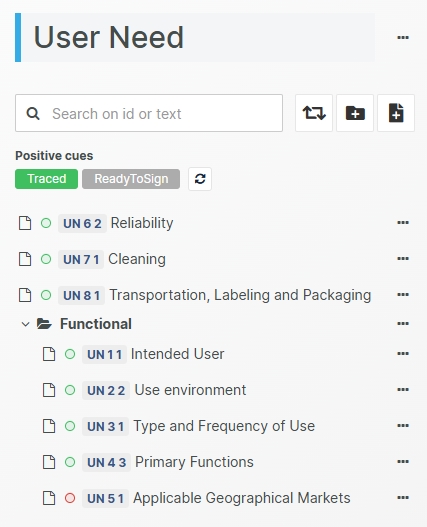Chapter View
The Chapter View displays the content (Document Objects and sub-chapters) of a chapter or book in a tree-like structure. This view is displayed; e.g., when you click on a Document Object type name in the Project Explorer or when you click on a chapter in the chapter path (breadcrumbs) displayed on the top of a Document Object form or when selecting Go to Chapter for a chapter in the Chapter View,
The Chapter view is divided into two areas. To the left, the chapter structure is displayed. The right area is reserved for displaying Document Objects in tab mode.
Display a Document Object in Tab mode
Click on a Document Object title in the Chapter View tree, the Document Object is displayed in a tab to the right of the Chapter Tree. Several Document Objects can be displayed as tabs simultaneously.
Display a Document Object in Full display mode
Click on a Document Object ID to display the Document Object in Full display mode.
Inspect Document Object "health" using Positive Cues
A Document Objects "health" can be displayed next to its ID as a coloured dot. This health status is called a Positive Cue in Aligned Elements.

A Positive Cue is a collection of inconsistency rules that are evaluated together.
If any of the rules are not fulfilled, the dot is coloured with a negative colour (usually red).
If all rules are fulfilled, the dot is coloured with a positive colour (usually green).
Each Positive Cue has a name. Click on the name in the Positive Cue bar to inspect the "health" status for that Cue. Toggle to a different Cue name to see the "health" for that Cue. Click the reload button to refresh the Cue state.
It is possible to configure any number of Positive Cues for a type. Each Cue is configured with a list of inconsistency rules, a positive and a negative colour and a name.
Chapter Actions
The following actions are available for the root chapter:
Add Document Object
Update Multiple Item
Add new Chapter
Rename Chapter
Remove Chapter
Rearrange Chapters and Document Objects
Export Chapter Structure
Import Chapter Structure
Display as List
Create Copy Multiple
Generate Multiple...
Display Inconsistencies
Display Consistency Coverage
Display Chart
Set Snapshot
Add Tag
Lock Document Objects
Generate Word Report
Generate Template based Word Report
Generate Excel Report
Create File for Objects
Import Document Objects
Export Document Objects
Document Object types that have File Attributes also have the options:
Save Files to Disk
Save Files as PDFs
Sub Chapter Actions
The following actions are available for subchapters:
Add Document Object
Add new Chapter
Rename Chapter
Edit Chapter Description
Remove Chapter
Export Chapter Structure
Import Chapter Structure
Go to Chapter
Display Inconsistencies
Display Consistency Coverage
Display Chart
Import Document Objects
Document Object Actions
The following actions are available for Document Objects:
Create Copy
Generate...
Trace To...
Trace From...
Find in Trace Explorer
Find in File
Find in Test Run Explorer
